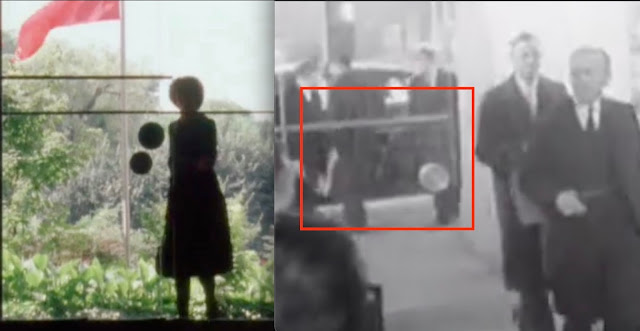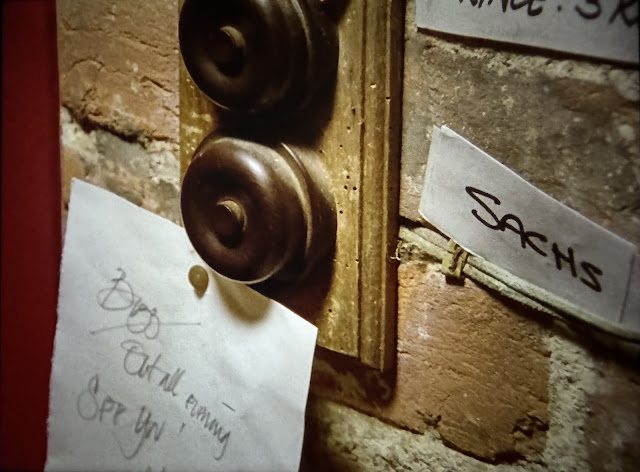Smiley's People - Paris Locations (Part Three)
Kirov instructed Madame Ostrakova to attend at the Soviet Embassy the next morning and we can assume that she'd have made her excuses at work and at 8:32 we see her at the wrought iron gate, the fence bearing the brass embassy plaque. I can only make out odd words on it such as 'Republic', 'from Union of Soviet Socialist Republics'. I have to assume that the BBC paid for a brass sign to be made, I wish I could find online a photograph of the genuine article but unfortunately since the bloc fell in 1989 they've been replaced with Russian Federation signs.
Each of the buildings on the campus are designated by a letter.
Then we see the iconic shot of Madame Ostrakova walking across the Embassy's courtyard and again with reference to the plan we can work out that Simon Langton's crew must've placed the camera on Building B to capture her approach to the entrance of Building C
In in-depth articles such as these the writer presents a film from the institution's website showing happy students enjoying the facilities (rather than studying all hours like we used to do) and here's ours. Watch closely, you might spot some of the locations from the programme.
You may have noticed an interesting caption about the history of this building in the film:
We don't of course know whose idea it was to choose this location but we here at the Guinness Is Smiley office 😉 can't help wonder whether David Cornwell (taking full advantage of his position as scriptwriter) was making a small joke at the expense of our closest allies.
Ostrakova's entrance into the building is filmed from inside building C and we can match the distinctive line across the door and the round door handles to a still from this short film of NATO arrivals in 1952.
First of all let's try matching up the stairs (by the way, notice the hammer and sickle sculpture in the background).
I immediately tried a reverse image search but the trouble is that the program is only too good at identifying the numerous Soviet symbols with which the location had been dressed. Refining my search by adding 'marble floor' or 'building in Paris' only confused matters. Fortunately at this point I was grateful for the advice of a Smiley's Person who revealed that there'd been no trip to Paris on the Beeb after all, because they filmed the interiors in London. About five minutes later after another search I was able to confirm that the location chosen was a building used for so many film, television and video productions and that is Crush Hall, University of London, Malet Street, Bloomsbury, WC1E 7HU.
We can see from the photo below that it's a match for our location.
And here it is in Batman Begins...
And here's the waiting area viewed from the stairs...
Now let's have a look at some of the set dressing we see on screen. First of all the desk must've been added, that's a thoroughfare rather than a reception area and it's the same with the sofa, complete with the comrades waiting their turn. Then there's the picture hanging where the wall lamp is:
I've tried to identify that room and it could be the Jessel Room but if not it still seems very likely they would have filmed both scenes with those actors at the same location.
Now I've seen that picture somewhere before, Control and I can't get a clearer image so the internet's no use but maybe there's one of you out there that can identify this slice of Soviet imagery. On that subject, how about a bust of Lenin. Go on, you know you've always wanted one!
And then there's the office where Attache Kuznetsov (played by Renny Krupinski) takes Madame Ostrakova to fill in the forms.
OK so we're nearly done. Just a couple of things to clear up.
I'm sure we can all imagine how such a hasty move would present significant security risks and opportunities for a real mole.
Kim Philby revealed how easy it was to steal secrets from the British secret service.''Every evening I left the office with a big briefcase full of reports that I had written myself, full of files and actual documents from the archive. I used to hand them to my Soviet contact in the evening. The next morning I would get the files back, the contents having been photographed and early the next morning I would put them back in their place.''
By the way, Paris Dauphine University haven't finished developing the Paris campus. This film shows another building planned for 2024.
AND finally Gita Denise.
Next time we take a train ride and Ostrakova realises she's been had...























Comments
Post a Comment